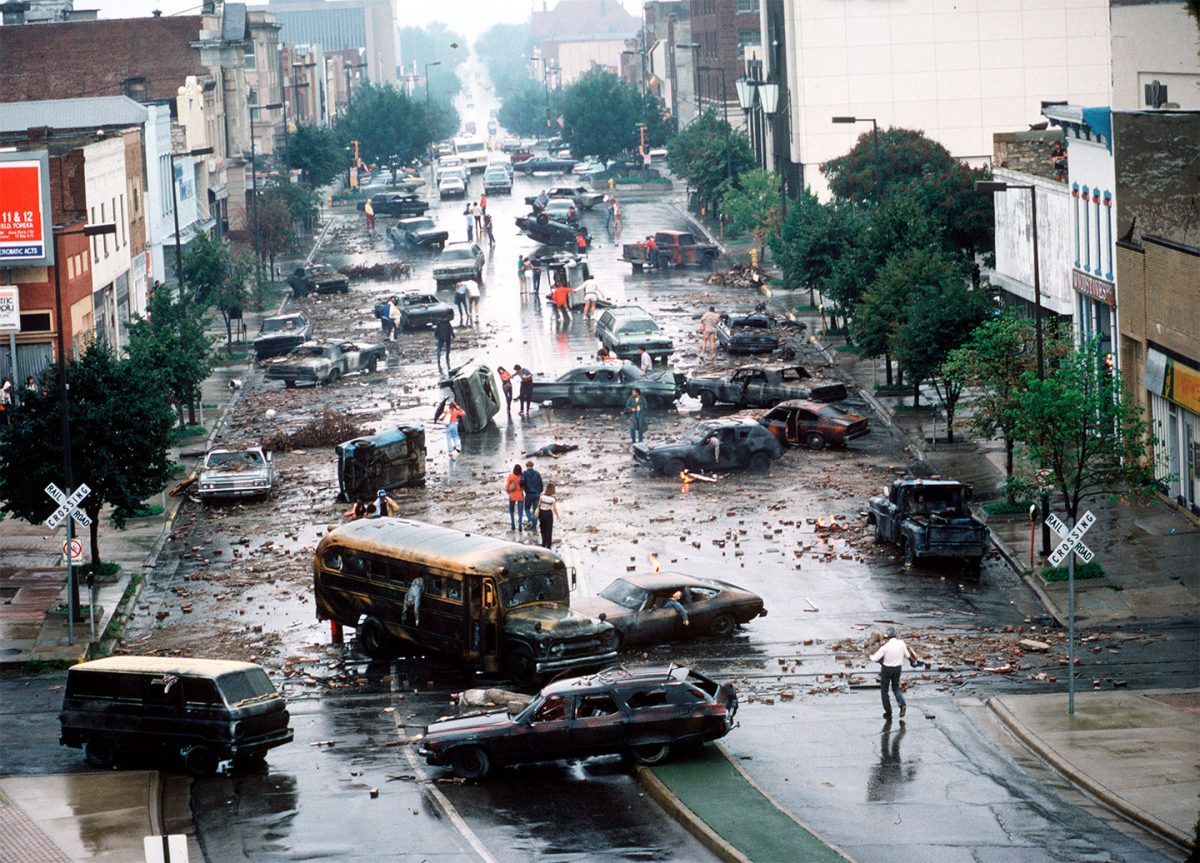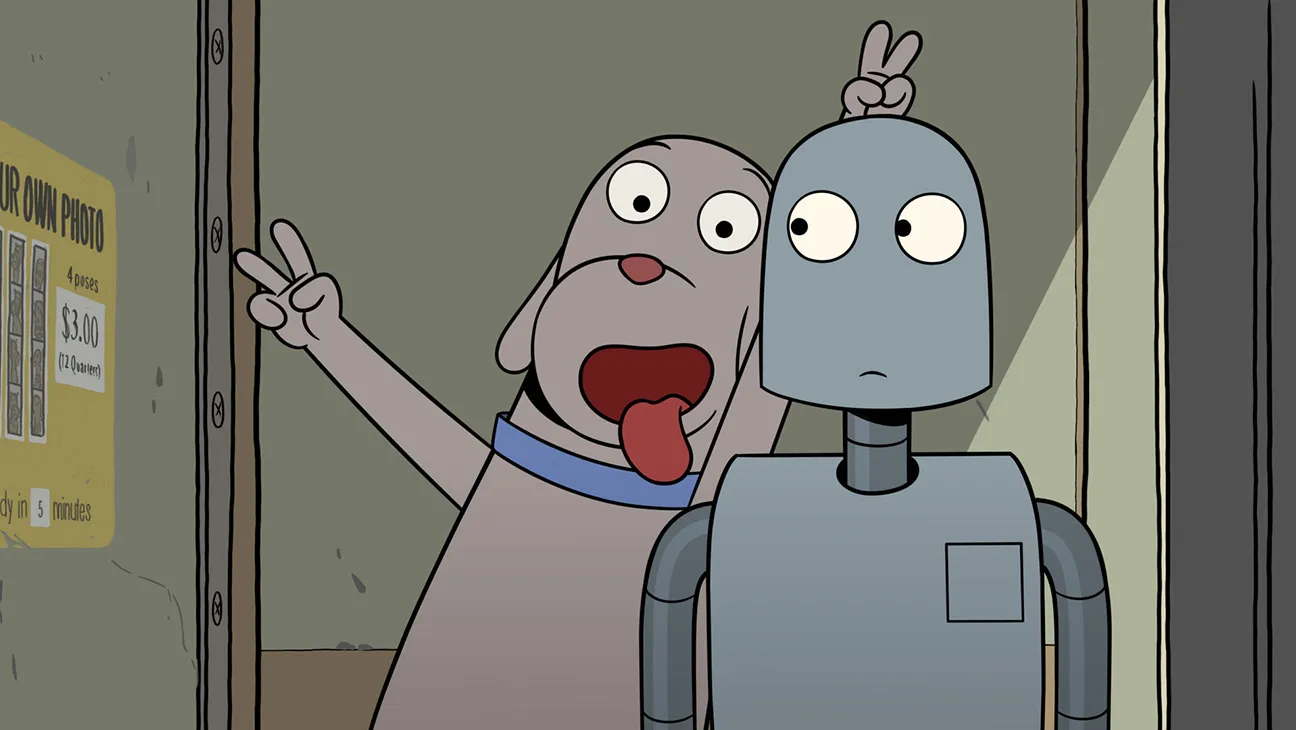The Nightmare Comes Home
Peanuts. Or so says a desperate, despairing physician in The Day After. Even Hiroshima was peanuts compared with the irrevocable thermonuclear slaughter visited on Kansas City and its environs. Lawrence. Sedalia. Green Ridge. They have all been devastated. But this is not some horrible, local nuclear accident. This is worldwide atomic warfare. The missiles have been launched, the bombs have gone off. The global village has been nuked.
No escape, no hope. And no happy endings either. Only the suggestion of a blighted tomorrow, full of radiation poisoning that desiccates survivors and deforms unborn children. Say this for The Day After: it has no patience for reassurance and makes no kind of political peace. It sets itself a relatively easy mark—to illustrate the ravages of nuclear war—but a punishingly high goal. It may be that no television film has ever had such ambition, or presumption, and just so no one misses the point, the network and the film makers spell it out in grave white letters just before the final fade: “It is hoped that the images of this film will inspire the nations of this earth, their people and leaders, to find the means to avert the fateful day.”
The Day After will not be broadcast until Nov. 20, but its political implications have already been discussed, denounced and championed by proponents and opponents of the nuclear freeze. ABC executives are united and adamant about the apolitical nature of their 2-hr. 5-min. presentation. “We never intended the film to be a political statement,” claims Brandon Stoddard, president of ABC Motion Pictures and the initiator of the project. “The movie simply says that nuclear war is horrible. That is all it says. That is a very safe statement.” Adds the film’s director, Nicholas Meyer: “The Day After does not advocate disarmament, build-down, buildup, freeze. I didn’t want to alienate any viewers. The movie is like a giant public service announcement, like Smokey the Bear.”
The movie has already started its fair share of brush fires. Tape copies leaked into circulation and were being screened for freeze sympathizers as long ago as July. Congressman Edward Markey, co-sponsor of a House freeze resolution, caught an early show and says, “It’s the most important television program ever because it’s the most important issue ever. It’s the most honest account of nuclear war that has been done.” “It’s an awesome film,” adds Congressman Thomas J. Downey. For Janet Michaud, executive director of the Campaign Against Nuclear War, “ABC is performing an enormous public service. It’s giving the American people the ability to become part of the debate over the most important issue of our times.” For Roger Molander, founder of the nuclear-war-education group Ground Zero, The Day After is a conduit to confrontation. “To come to grips with the reality of nuclear war, one has to go through a nuclear passage, to confront a nuclear war in all its horror. This will provide a passage for 30, 40, 50 million Americans.’’
Television networks, which like to hear numbers like that, nevertheless give a collective corporate shudder at the slightest hint of advocacy. “ABC’s responsibility is to the film itself.” says Stoddard. “How it is perceived or used by other people is beyond our control.” That may be, but the freeze supporters have made a strong head start. Leaked copies of The Day After are being shown at antinuke fund raisers, while the opposition has been effectively shut out. “This film has been used to generate interest and support, including financial support, for our efforts,” Michaud admits.
Paul Dietrich, president of the conservative National Center for Legislative Research, wangled himself an invitation to a private showing and calls the film “anything but nonpartisan.” Says John Fisher, president of the American Security Council: “Clearly someone associated with the production has a significantly different perspective than we do, because somehow the pirated version hasn’t been exposed to people on our side of the issue. This movie says deterrence has failed, and that’s a political statement.”
Having made the film their own, freeze advocates are now using it, in the words of Disarmament Activist Josh Baran, “to educate people. It is the best use of television I can think of.” Last April, Baran helped start an ad hoc organization called The Day Before, which will work with 17 national antinuclear groups to set up seminars in more than 100 cities around the country for two days following the film’s air date. Ground Zero will mail out 100.000 viewing guides. The Center for Defense Information is considering producing a 60-sec. commercial, narrated by Paul Newman, offering “a nuclear war-prevention kit.” “I plan to send in for one of those kits,” writes Conservative Columnist William F. Buckley Jr., “and if Mr. Newman doesn’t send me an MX missile, I’m going to report him to the Postal Service people for fraud.”
All this heat and dust have made advertisers, already shy of buying time on such a dubiously commercial program as The Day After, almost paralyzed with reluctance. By some accounts, the network has lined up four or five sponsors; by others, it has sold only half the 25 available 30-sec. commercial spots. “I couldn’t confirm half, but I know it’s a good portion,” comments Jeff Tolvin, ABC’s director of business information, with gingerly care. The network is charging a hefty $135,000 a spot—a price that could dip as show time approaches and empty air time looms—but the problem, according to Madison Avenue, is not monetary. “It may be one of the most devastating pieces of film I’ve ever seen, TV or otherwise, but it is artistically unsuitable to most of our clients,” says Joel Segal, senior vice president of broadcasting for Ted Bates Advertising. ‘‘It isn’t the issue of controversy: it’s more a matter of the commercials’ conflicting grossly with the content of the program.” Asks another agency executive: “Do you want singing and dancing and music in that kind of program environment?”
The scenario is not too elaborate or cynical for the byzantine world of show biz: sponsor recalcitrance triggers stress. Tapes are leaked, positions taken, battle lines drawn, articles written. No movie since CBS’s 1980 Holocaust film Playing for Time has stirred such a dust devil of ideological p.r., but the stakes are even larger here. The Day After cost an opulent $7 million, and its promotion budget may ultimately equal that figure. ABC, gambling that it will make up in ratings what it misses in ad dollars, schedules the film for sweeps week, when the three networks all go for broke in the ratings. The timing is perfect: Nov. 20 is not only a Nielsen trifecta, it is less than two weeks before the Pershing IIs are due to be installed in West Germany. More controversy, more publicity. Is the timing a reflection of political intent as well as business expediency? The network firmly denies it. The National Review editorializes that ABC is making “a $7 million contribution to the faltering campaign against the deployment of the Pershing II.” So The Day After lumbers in carting more weight than Mother Courage.
For all this, the film’s beginnings were astonishingly humble: Brandon Stoddard saw The China Syndrome and wondered what the home-front consequences of nuclear war would be. When Nicholas Meyer met Jason Robards on an airplane and offered him the lead role of a humanistic surgeon. Robards accepted with elegant simplicity. “It beats signing petitions,” he said. Now that The Day After has been temporarily positioned right at the center of the nuclear debate, there is no more room for humility or modesty. The finished film was premiered last week in Lawrence. Kans.. where much of it had been made on location, and the townspeople were tearful and shaken. Stoddard reports he wept when he saw the first cut of the film and says the present version “is the most important thing I have ever done.” Director Meyer calls the movie “the most valuable thing I’ve ever done with my life.” Mayor David Longhurst has invited Ronald Reagan and Yuri Andropov to Lawrence for a summit. Another Lawrence citizen, Bob Swan, member of the antinuke Let Lawrence Live organization, says he is trying to link up his home town by television or telephone to Leningrad, so that Soviets and Americans can hash things out person to person. After the broadcast, ABC will put on a special 45-min. edition of Viewpoint, anchored by Ted Koppel. The show, intended as both a kind of emotional decompression chamber for viewers and a debating platform between friends and foes of the freeze, has an additional, and certainly not accidental, function. It gives The Day After the weight of a major news event.
Nothing, however, can give it the substance. Under all the furor, spontaneous or manufactured, and the high urgency, real or prefabricated just for the premiere, is the film, a frail vessel indeed to bear the fate of mankind. History and distance have not made Stanley Kubrick’s 1964 film Dr. Strangelove any less great or—sadly—less relevant, but even a movie as fine as that would have to struggle to stay above the sort of ideological tide surging around The Day After. No one has yet made the case that Dr. Strangelove has been bested, although there are suggestions, even from Meyer, that it has been beaten out in the high earnestness sweep- stakes. Meyer concedes his movie “has a minimum of imagination” but thinks Dr. Strangelove is “distilled through comedy,” which presumably means that his own enterprise, being so conspicuously short of humor, serves some loftier social purpose. This type of cultural con is a piece of undiluted show-biz self-protection, and a good thing too. Political immediacy is just about all The Day After has going for it. By any standards other than social, it is a terrible movie.
The film is so aimlessly anecdotal in its opening positions that there is little dramatic connection between the characters. Reality is so quickly and cursorily observed that there seems nothing else to do but bring on the bombs. There are no people here, only targets, stick figures on a Midwestern landscape waiting to be wasted. A kind of predictable character collage revolving erratically around the travails of Robards’ nicely realized surgeon, the movie misses dramatic force because it has no center. It does, however, have a centerpiece, a 4-min. sequence representing the atomization of Middle America and, by extension, much of the rest of the world.
People turn where they stand into living X rays just before they disintegrate entirely. Fire storms swallow-up towns. The images of destruction, mild for a theatrical movie and practically gentle by any factual measure, are still startling by American television standards, and they pack force. Once this montage of immediate death ends, however, The Day After has to get back to its characters, which is to say that it must run on empty. Nuclear annihilation may be the subject, but the film appears to have been the victim of an editorial chain-saw massacre. Whatever the executive reasons for reducing its three-hour running time to just over two may have been, considerations of dramatic coherence cannot have numbered high among them. The female lead (Jobeth Williams) dies off-screen, her passing noted in just a line or two of dialogue. Another major character, a farmer and family man (John Cullum), gets shot by squatters, and his widowed wife and orphaned children react only by turning toward the sound of the gun. Characters tumble in and out like cards in a dropped deck.
Paradoxically, when the film is vaguest it is often at its strongest. Impending nuclear war is announced in a series of bulletins on radio and television, casually broadcast and half-heard at first. The sound track carries snatches of references that accelerate to slightly longer descriptions of airport blockades and MiG-25s “invading West German airspace” and that end, finally, with a shocked anchor-woman saying. “Three nuclear weapons in the low-kiloton range were airburst this morning over advancing Soviet troops.” There is only calamity after that. ABC’s determination to keep up appearances of political evenhanded ness have helped the film makers conjure up w hat seems like a spookily accurate scenario for Armageddon: the beginnings of worldwide disaster as a series of barely overheard fragments. This is global tragedy with no fixed responsibility.
Screenwriter Edward Hume and the film makers were correct in choosing to avoid blaming either the U.S. or the U.S.S.R. for the initiation of catastrophe. This moral neutrality may be one reason the network is actually going to broadcast their film, advertisers or not, champions or not, critics or not. Less than 20 years ago, the BBC refused to show Peter Watkins’ very similar but far more devastating The War Game because it was “too horrifying.” The Day After, nowhere near as strong or as skillful, is still frightening enough, and here it is, occupying more than two hours of prime commercial network time. But such a signal of cultural change can also be an intimation of trouble. The generally shabby quality of The Day After is of major concern because, rather than startling audiences into a new awareness, it is just as likely to anesthetize them with mediocrity.
This process will not stop with The Day After. Paramount already has a movie in the pipeline called Testament, about one family trying to survive a nuclear blast. One of the hottest commercial novels due next spring is Warday by Whitley Strieber and James Kunetka, which shows America reeling from atomic desolation and California, intact and safe, effectively closed to the rest of the country. “There’s a hell of a percentage increase in these day-after-nuclear scripts,” says Michael Fuchs, president of Home Box Office’s entertainment group. Apocalypse has clearly become something more than the fate that looms just over the horizon line. It may be the growth industry of the ’80s. —By Jay Cocks. Reported by Peter Ainslie/New York and Denise Worrell/Los Angeles
Time, October 24, 1983





